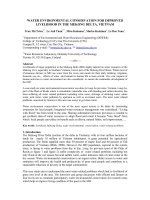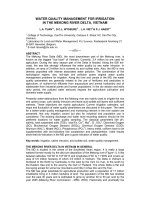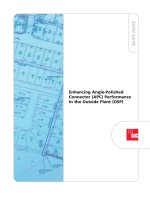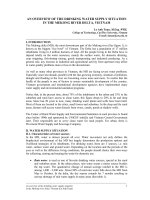Tài liệu Sustainable water management for rural development in the Mekong river delta, Vietnam pptx
Bạn đang xem bản rút gọn của tài liệu. Xem và tải ngay bản đầy đủ của tài liệu tại đây (62.38 KB, 6 trang )
The second International Symposium on Southeast Asian Water Environment
Hanoi, Vietnam, 1-3 December, 2004
1
SUSTAINABLE WATER MANAGEMENT FOR RURAL DEVELOPMENT
IN THE MEKONG RIVER DELTA, VIETNAM
L.A. TUAN
1*
, G.C.L. WYSEURE
2
, L.H. VIET
1
1
College of Technology, CanTho University, Campus II, Street 3/2, CanTho City, Vietnam.
* E-mail:
2
Laboratory for Land and Water Management, K.U Leuven, Kasteelpark Arenberg 21,
B-3001 Heverlee, Belgium
Abstract:
The Mekong River Delta (MD) in Vietnam has an area of 4 million hectares. The
economical production in this region is highly dependent on water from the river and
canal system. More than two-third of 17 million inhabitants of the MD live in rural
areas and depend totally on the water resources for rice, upland crop irrigation,
aquaculture of fish and shrimp, domestic drinking and industrial water supply and for
transportation on rivers and canals. In the MD agricultural production consumes
around 85% of the total water supply. Approximately 2 million tons of rice, produced
in the MD, are yearly exported from Vietnam to the rest of the world. The rapid
expansion of intensified agricultural cultivation and urbanization leads to water
resources pollution. Shortage of good quality water becomes increasingly a great
challenge to the sustainable water management. How to control the quantity and
quality of the water efficiently is an important key factor for rural development. This
paper will present some data figures and discussion concerning the current problems
and strategies to alleviate the bottlenecks in water management.
Keywords: sustainable water management, rural development, water quantity and
quality.
1. INTRODUCTION
The Mekong river (see figure 1) with the length of 4,200 kilometers is the 12
th
longest
river in the world, its source originates at an altitude of 5,181 meters on the Tibetan
Plateau. The river flows down through Southwest China, passes a part of Myanmar,
runs a long the boarder between Thailand and Laos, then goes throughout Cambodia
and finally reaches out into the East Sea in Vietnam. From year to year, the Mekong
River Delta (MD) of Vietnam have been deposited alluvium by the over bank flooding
that this land becomes a typical river delta as a great potential region for agricultural
production for the whole country.
The Delta accounts only 5% of the total the water
basin of the Mekong river, about 4 million hectares, but it supplies for more than 50%
of staple food, 60% of fish and shrimp and 70% of tropical fruits. It has contributed
approximately 2 million tons of exported rice yearly to the world.
The second International Symposium on Southeast Asian Water Environment
Hanoi, Vietnam, 1-3 December, 2004
2
There are three water quality problems and two water quantity problems that are the
principal limit factors of agricultural production in the Delta
(i) The salinity intrusion: There are more or less 2.1 million hectares of the MD
coastal areas (50%) affected by salinity during the dry season from
December to May.
(ii) The acid sulfate soils (ASS): Large areas of Long Xuyen Quadrangle and
Plain of Reeds and other scattered lands, cover 1.6 millions hectares (40%)
of the MD are holding the soil with high iron sulfide content.
(iii) The polluted water: The Mekong river is facing more and more water
pollution by agricultural and industrial chemicals and domestic untreated
wastewater. In some places, this situation is threatening seriously the public
health and socio-economic development.
(iv) The shortage of fresh water: In the dry season, the average discharge of the
Mekong river is lower then 2,500 m
3
/s down to 1,700 m
3
/s. In addition the
groundwater table lowers by 2 to 3 m.
This water amount is not enough to
irrigate nearly 1,5 million hectares of cultivable lands in the dry season. The
shortage of freshwater leads to increasing salinity intrusion throughout the
MD coastal provinces.
(v) The floods: Discharge of the Mekong river during the wet season averages of
39,000 m
3
/sec. About 1,2 - 1,9 million of hectares of the southwestern part of
the Delta can be flooded where farming becomes impossible.
Although seawater intrusion and floods are considered as limiting factors for
agricultural cultivation, they also have positive impacts: Many coastal farmers need
saltwater to raise shrimp; and flood flows are to bring alluviums for the fields, to flush
polluted water, crop insects to the sea and to supply fishes for the people. All the
socio-economic activities in the MD highly depend on the water resources for living
and production
A typical characteristic of a very flat delta as the MD is the small difference natural
level between the sea level in river estuaries and the inner lands. Also the MD is
Figure 1: The Mekong River and the MD map
The second International Symposium on Southeast Asian Water Environment
Hanoi, Vietnam, 1-3 December, 2004
3
affected simultaneously by 2 different types of complicated tides from the East Sea
(irregular semidiurnal tide) and the West Sea (irregular diurnal tide) with a great
difference amplitude. These create technical difficulties to drain the excess and
polluted water to the East Sea.
2. RURAL DVELOPMENT IN THE MEKONG DELTA
The MD is affirmed as a biggest agricultural region of Vietnam. It contributes for more
than half of Vietnam's total agricultural output, and 27% of Gross Domestic Product
(GDP). The MD has 17 million inhabitants (22% of country total), more than two-third
among them, farmers and agricultural related workers, are living in the rural and
coastal areas where the natural conditions such as lands, water and plants closed
density exist. The rest of the MD's population concentrated in the cities, peri-urban
areas, mainly along the major roads and waterways. Along the Tien river and Hau
river in Vietnam of the Mekong river system every 60 kilometers we have a major city
or town. The human settlement points fit a compromise between East Sea tidal
effects and the Mekong river flow. The population pressure and the economic
development needs have also driven the farmers to increase their income by
increasing and diversifying their agricultural and fishery production. Since the past 20
years, the area of cultivable lands have been growing by an expansion the irrigation
and drainage canals density system in the Delta. However, parallel with the fast
increasing agricultural yields and production, the region is facing more and more
water pollution problems by human and animals waste, agro-chemicals as pesticides,
herbicides, fertilizers. Flood disasters in the MD led to the loss of more than 1,000
human life and about 1 billion USD damages by in the past decade.
For rural and agricultural development in coming years, water needs for the whole
MD will mainly include:
irrigation water in dry season for 1,8 million hectares of rice fields as roughly
1.1 to 1.2 liter per second per hectare (l/s.ha) and for nearly 200.000 hectares
of perennial fruit trees and industrial crops. Water use in the Mekong delta in
1995 was estimated as 210 million m
3
as compared to 534 million m
3
used by
the whole Vietnam (Su, 1996).
domestic water supply for 11 million people in rural areas with the water rate
60 litres per person per day. The need for the rural population is established
as approximately 1 million cubic meter per day.
3. DISCUSSION ON SUSTAINABLE WATER MANAGEMENT
Sustainable water management (SWM) should not only control the water resources
towards the present needs but also consider water-related problems in the future.
Processes of the urbanization and industrialization parallel to the rapid population
growth lead to a greater water demand for upholding and developing the regional
economic. This issue in the MD is also unique for whole Vietnam and the water
needs of people may be linked the effort of poverty reduction and living conditions
improvement as well.
There are three issues to be noticed for SWM in the MD:
Water quantity and quality control
Water distribution and use
Water-related health and environmental needs
The second International Symposium on Southeast Asian Water Environment
Hanoi, Vietnam, 1-3 December, 2004
4
3.1 Water quantity and quality control
Water resources in the MD should be monitored and controlled both in their quantity
(discharge, water level, …) and quality (pH, TSS, turbidity, BOD, COD, DO, total
nitrogen, total phosphorus, total coliform number, …) according the economical and
environmental development requirements. The changes in space and time their
characteristics need to be recorded for making a necessary balance analysis. The
water quality monitoring routines may be suggested as figure 2:
Figure 2: Suggested water quality monitoring routines
3.2 Water distribution and use
Water in the MD flows though natural and artificial streams by gravity and open
channel flow. In principal, we could try to distribute water according to the human
demands by solving the water balance problems and by building a water resources
distribution system, which includes pumping stations, sluices, canals, pipelines
networks… (see figure 3). As every place has in their close vicinity open water a
water distribution solvency is not an economic option. In some cases, shift into less
water demanding crop cultivation or a resettlement of the rural living and production
into less water consumption is imposed.
3.3 Water-related health and environmental needs
In the rural areas of the MD, farmers access water directly from rivers, canals, ponds
or shadow wells (Tuan, 2003). By lack of adequate water sanitation facilities the
increase and prevalence of Anopheles and Dengue
mosquitoes together with other
disease vectors is observed. The seasonal transition periods are mostly affected.
Some going- on industrial projects have caused pollution of freshwater, intrusion of
salinity, water logging of agricultural land, destruction of wetlands and loss of
biodiversity in mangrove forest and coastal areas.
These negative impacts are slow
the rural development in the MD down in the present and future. It is necessary to
assess the economic development benefits with the health and environmental
impacts in early planning stages. Each result should be presented fully for the entire
Water
Monitoring
Network
Water
Sampling
Collection
n
Laboratory Analysis
and Data Handling
Water Quality
Modelling
Result
Information
Decision-
Making
The second International Symposium on Southeast Asian Water Environment
Hanoi, Vietnam, 1-3 December, 2004
5
population by the public media. Consideration and feedback is required in order to
establish a balance of good quality water with sufficient quantity (figure 4).
Figure 3: Establishing water resources systems in the MD
Figure 4: Relationship concerned health and environmental needs
WATER RESOURCES
Flow forms:
+ Rainfall
+ Surface water
+ Groundwater
Water characteristics:
+ Quantity
+ Quality
+
Dynamics
WATER DEMANDS
Irrigation
Domestic uses
Fisheries
ASS reclamation
Salinity prevention
Pollution control
Land washing
etc.
WATER BALANCE
WATER RESOURCES SYSTEMS
WATER
DECISION-MAKING
Satisfy ?
No
Adjust
demands
Yes
Monitoring
National and
Regional Policies
Economic
Development
O
bjectives
Water
Budget
Monitoring Network
Water Demand
and Supply
Analysis
Community
Public
Information
and Feedback
Water Alternatives
Solutions
and Environmental
Impact Assessments
Cost-Benefit
Analysis
and Nonprofit
Consideration
Decision Makers
Decision
Reports
Implementatio
n
Health and Environmental Monitoring
The second International Symposium on Southeast Asian Water Environment
Hanoi, Vietnam, 1-3 December, 2004
6
4. CONCLUSION
Some past rural development projects concerning water management in the Mekong
River Delta are evaluated as non-sustainable. Some projects only considered the
single objectives advantages and did no study human health, environmental impacts,
water quantity-quality relations. The decision-making process was top-down with little
or no public involvement of the different stakeholders.
Water in the MD is important factor in all future planning activities. Although the
quantity of water inthe delta is large, the sufficient good quality could become a
bottleneck as pollution increases along with a higher demand. So a sustainable
water management should be interpreted with the targets of the rural development as
meaning water resources system has used to be efficient.
5. ACKNOWLEDGEMENTS
Authors would like to say sincerely thanks the Belgium - CanTho University VLIR-E2
project and project staff members for their support.
REFERENCES
P. J. Haest (2003). The Influence of Long Xuyen City on the Water Quality of the Hau
river (Mekong Delta). Master Thesis. K.U.Leuven, Belgium.
K.A. Keola (1997). Water Quality Monitoring Network in the Lower Mekong Basin.
MRC Workshop "Urbanization and Safeguarding Water Resources in Mekong
Riparian Countries", CanTho University, Vietnam.
Ministry of Agriculture and Rural Development (2003). Atlas of Some Selected
Hydraulic Works of Vietnam. Hanoi, Vietnam.
L. Q. Minh (2002). Transboundary Cause-effects of Upstream Development to
Environment and Livelihoods in the Mekong Delta, Vietnam. Mekong Dialogue
Workshop “International transfer of river basin development experience: Australia
and the Mekong Region”, Australia.
P. X. Su (1996). Country Paper of Vietnam. In (W. L. Arriens, J. Bird, J. Berkoff, et
al., eds.) Towards Effective Water Policy in Asian and Pacific Region: Volume 2 -
Country Papers. Proceedings of the Regional Consultation Workshop – Towards
a Policy for Water Resources Development in the Asian and Pacific Region.
Manila, Philippines, 10-14 May 1996. ADB Manila.
L. M. Triet, D. H. L. Chi, N. P. Dan (1997). Environmental Quality Monitoring Results
of some Mekong Delta Provinces In the Two Years 995 - 1996. Proceedings of
the workshop on "Urbanization and Safeguarding Water Resources in Mekong
Riparian Countries". CanTho University, Vietnam.
L. A. Tuan (2002). An Overview of the Drinking Water Supply Situation in the Mekong
River Delta. Proceedings of the SANSED Project Workshop. CanTho University,
Vietnam









